Why Taiwanese Food Is So Good
Taiwan may be known for its tech and mountains, but for food lovers, it’s nothing short of paradise. Eating in Taiwan isn’t just a meal. It’s an experience. So if you’re planning a trip, or just curious about the hype, remember this: come hungry, stay curious, and never skip the night markets. If you’ve ever found yourself dreaming about noodles, buns, or bubble tea, then Taiwan is your culinary soulmate. This little island punches way above its weight when it comes to food, and once you taste your way through it, you’ll understand why locals and travelers alike are obsessed. All in all, Taiwanese cuisine strikes the perfect balance between comforting and mouth-watering. Whether it’s a bowl of piping hot noodles, a fluffy pork belly bun, or icy mango snow, there’s always something to satisfy you. It’s food that feeds your soul and is delicious, familiar, and comforting. So what makes Taiwanese food so insanely good?
Bold Flavors, Perfectly Balanced
Taiwanese cuisine is all about harmony. You’ll find sweet paired with salty, spicy balanced by sour, and savory dishes that finish with just a hint of sweetness. Take lu rou fan (braised pork rice), for example—it’s a humble bowl that somehow packs richness, saltiness, sweetness, and melt-in-your-mouth texture all in one. Or beef noodle soup, where the broth simmers for hours, layering spice, herbs, and beefy goodness. This isn’t just food. It’s alchemical perfection.
Deep Culinary Roots
Taiwanese cuisine has a long history. You can trace influences from mainland China, especially Fujian cooking, as well as colonial-era Japanese flavors, Aboriginal traditions, and even Southeast Asian flavors that emerged from immigration and trade. The result? A cuisine that’s rich in identity and flavor. Every dish tells a story, and it tastes like it, too.
Street Food Is an Art Form
In Taiwan, street food isn’t an afterthought. It’s a way of life. Night markets light up across the island every evening, filling the air with the smell of fried chicken, sizzling scallion pancakes, and stinky tofu (yes, it smells wild, but it’s delicious). Vendors often specialize in a single dish, perfecting it over years. You’re not just getting a snack. You’re getting a tiny masterpiece.
Fresh, Local, and Seasonal
The island’s geography means access to a stunning variety of produce – mangoes, lychees, bamboo shoots, greens, herbs, and super-fresh seafood. Markets buzz daily with seasonal finds, and whether you’re eating in a five-star restaurant or at a roadside stall, you can taste the freshness.
20+ Must-Try Foods in Taiwan
Taiwan Food Guide: Taiwanese food isn’t just about snacks. It’s a whole culture, a nightly ritual, and a delicious introduction to the island’s rich culinary roots. Taiwanese food scene is a vibrant tapestry of flavors, textures, and cultural influences. From bustling night markets to humble street corners, here are 20 must-try Taiwanese street foods that showcase the flavor, culture, and creativity found in night markets and street stalls across Taiwan.
What to eat in Taiwan Night Markets? Read Top 10 Street Foods in Taiwan Night Markets and Top 100 Taiwan Famous Food
Stinky Tofu
If you’re exploring Taiwan’s legendary night markets, there’s one dish you’ll likely smell before you see – Stinky Tofu Loved by locals and daring foodies alike, this fermented tofu dish is notorious for its strong, pungent aroma, often compared to blue cheese, dirty socks, or even garbage… but don’t let that scare you off. Because once you get past the smell, you might just fall in love.
Stinky tofu is made by soaking tofu in a fermented brine and is often a secret family recipe involving fermented milk, vegetables and meat. After it absorbs all that funk, the tofu is typically deep-fried until golden and crispy on the outside, while staying silky-soft inside. It’s commonly served with pickled cabbage, garlic soy sauce, and spicy chili, creating a powerful mix of flavors and textures in every bite: crunchy, creamy, tangy, and spicy.
There are also regional variations: In northern Taiwan, it’s often fried and served dry with sides. In southern Taiwan, you might find it braised in a spicy stew. Some versions are barbecued on skewers, giving it a smoky twist. Despite its off-putting aroma, stinky tofu is a beloved comfort food in Taiwan and a rite of passage for any adventurous eater. It’s a dish that teaches you not to judge a food by its smell — because the flavor payoff is real.
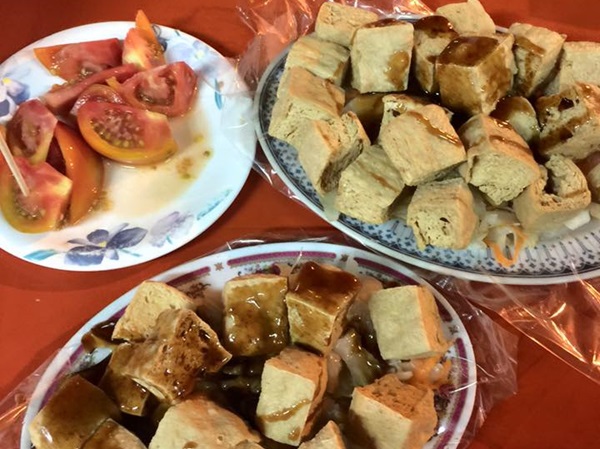
Deep-Fried Chicken Cutlets
When it comes to comfort food with a crunch, Taiwanese Fried Chicken is a street food superstar. Whether it’s the giant chicken cutlets or bite-sized popcorn chicken, this golden, crispy delight is one of the most iconic snacks in Taiwan’s night markets. The magic starts with a well-marinated piece of chicken – typically thigh or breast – that’s been soaked in a flavorful mix of soy sauce, garlic, five-spice powder, and rice wine. What sets it apart is the batter: it’s often coated with sweet potato starch, which gives it that signature extra-crispy, crackly crust.
Once fried to perfection, it’s usually dusted with seasoning powders – think chili, plum, seaweed, or the ever-popular garlic salt — and sometimes topped with fried basil leaves for an aromatic twist. The large chicken cutlets are flattened and cut to the size of your face, making them perfect for eating on the go. Meanwhile, popcorn chicken is perfect for sharing and dipping.
As big as your face and seasoned with a blend of salt, pepper, and sometimes chili, this ultra-crispy fried chicken cutlet is a night market classic. Hot-Star (豪大大雞排) is the OG, but you’ll find delicious variations everywhere.
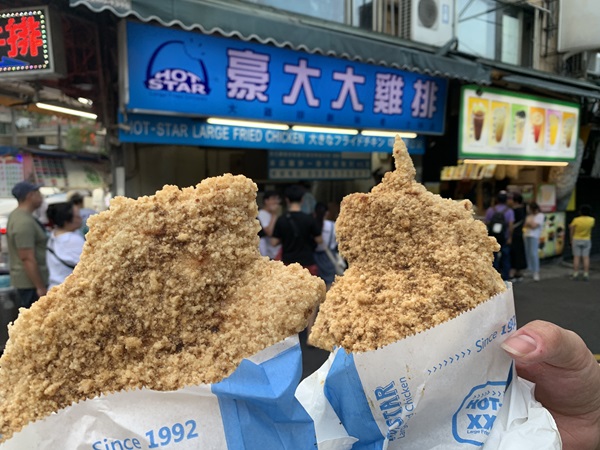
Pepper Popcorn Chicken
If there’s one snack that perfectly captures the spirit of Taiwanese night market eats, it’s Pepper Popcorn Chicken. This bite-sized, ultra-crispy chicken is juicy on the inside, packed with flavor, and dusted with a punchy mix of salt, pepper, and five-spice. Often paired with fried basil leaves and eaten piping hot from a paper bag, it’s the ultimate crispy, savory, and spicy street food experience.
Pepper Popcorn Chicken is a deep-fried, seasoned chicken snack, typically made from boneless thigh meat that’s marinated, coated in a starchy flour (often sweet potato starch), and then fried until golden and crunchy. What sets it apart is the generous seasoning: salt, white and black pepper, and sometimes a touch of five-spice powder-plus the iconic crispy basil leaves tossed in right at the end. Served in small portions meant for snacking, it’s a Taiwanese version of fried chicken that’s bold, aromatic, and designed to be eaten hot, crispy, and with your fingers.
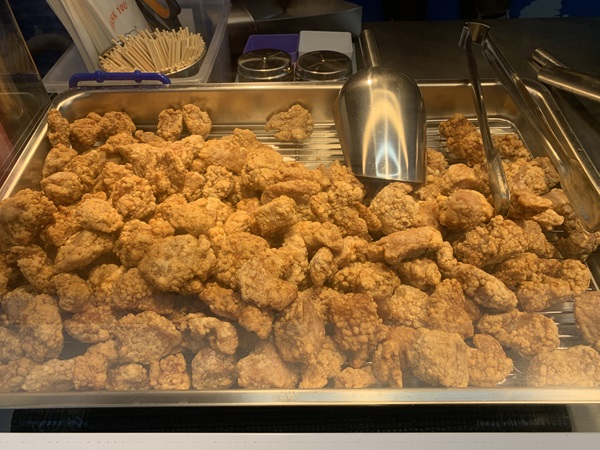
Oyster Omelette
Few dishes scream “Taiwan night market” quite like the Oyster Omelette — or “O-a-Chian” in Taiwanese Hokkien. This unique street food is a mouthwatering mix of land and sea, with a texture and flavor profile that surprises and delights first-timers.
At its core, the oyster omelette is made with fresh, plump oysters, eggs, and a batter of sweet potato starch, which gives the dish its signature chewy, gooey texture. Unlike your typical omelet, this one is pan-fried until slightly crispy at the edges, while the middle stays soft and sticky.
What really takes it over the top is the sweet-savory red sauce ladled generously over the top — a blend of ketchup, soy sauce, sugar, and sometimes chili. The sauce is the finishing touch that balances the briny oysters and the richness of the egg.
Served hot and often with a little side of pickled vegetables or greens, the oyster omelette is hearty, comforting, and totally one-of-a-kind. It’s a beloved favorite across Taiwan, especially at night markets like Ningxia.
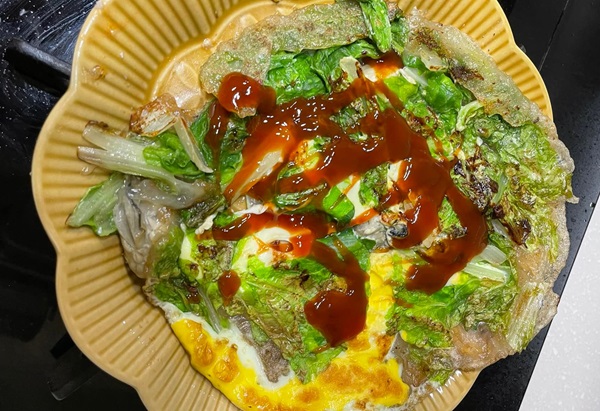
Grilled Taiwanese Sausage
Sweet, juicy, and a little sticky on the outside, these sausages are often grilled to perfection and served on a stick. Try the famous “small sausage wrapped in big sausage” (大腸包小腸)—a grilled sausage wrapped in sticky rice “bun” with garlic, pickled veggies, and sauces. It’s like a Taiwanese hot dog, but way better.
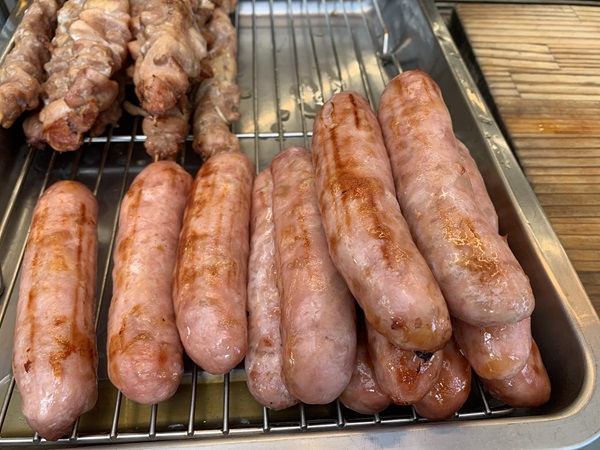
Lu Rou Fan
If there’s one dish that truly embodies the soul of Taiwanese home cooking, it’s Lu Rou Fan, or braised pork rice. Simple, hearty, and packed with flavor, this humble bowl of goodness is a staple in homes and eateries all across Taiwan. Lu Rou Fan features minced or finely chopped pork belly, slowly simmered in a rich, savory sauce made from soy sauce, rice wine, sugar, garlic, five-spice, and shallots. The result? A luscious, caramelized meat topping that’s spooned over a bed of fluffy white rice, soaking it in that flavorful glaze.
Despite its simplicity, every family and food stall has its own take – some versions are saucier, while others are drier and more intensely flavored. Some come with a hard-boiled soy egg, pickled vegetables, or a chunk of braised tofu on the side. This dish is beloved not just because it’s delicious, but because it’s comforting and it tastes like home. Whether you’re at a street stall, in a lunchbox shop, or at a grandma’s kitchen table, Lu Rou Fan delivers pure Taiwanese soul in every bite.
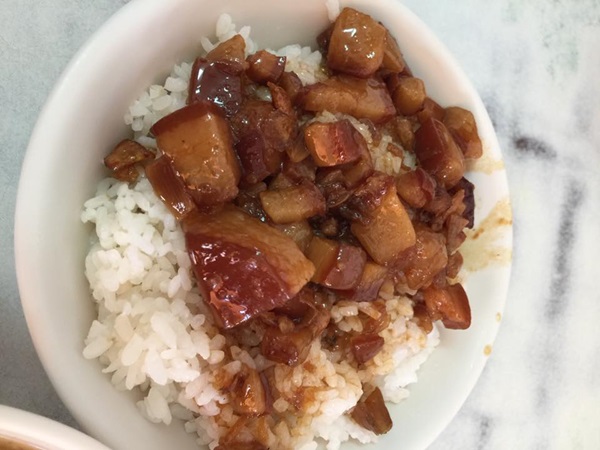
Xiao Long Bao
Delicate, juicy, and bursting with rich broth, Xiao Long Bao is one of Taiwan’s most iconic and beloved dishes. Often called soup dumplings in English, these little steamed parcels are a culinary masterpiece—thin, pleated wrappers that hold a savory pork filling and a pocket of hot, flavorful soup inside.
Xiao Long Bao are steamed dumplings filled with meat (usually pork) and a rich, savory broth that melts into liquid during steaming. The name means “small basket bun,” referring to the bamboo steamer baskets they’re cooked and served in. Each dumpling is carefully folded with multiple pleats (usually 18), then steamed until translucent and piping hot. One bite releases a burst of flavorful soup, followed by the tender, juicy filling.
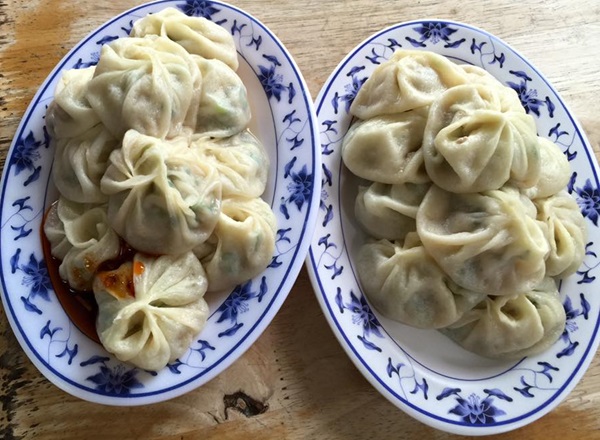
Peanut Roll with Ice Cream
A truly unique and delightfully unexpected Taiwanese dessert, Peanut Roll with Ice Cream is a handheld treat that brings together cold, creamy ice cream, sweet peanut shavings, and chewy flour crepe in the most magical way. It’s light, flavorful, and refreshing—a perfect street snack for hot days or whenever you’re in the mood for something sweet with a twist.
Imagine this: a soft, paper-thin crepe-like wrapper, filled with freshly shaved peanut brittle, scoops of taro or pineapple ice cream, and a touch of fresh cilantro-yes, cilantro. Then it’s rolled up like a burrito and handed to you, ready to eat. This dessert might sound unusual, especially with the herb, but somehow it all works beautifully. The flavor combo is nutty, creamy, sweet, herbal, and refreshing all at once.
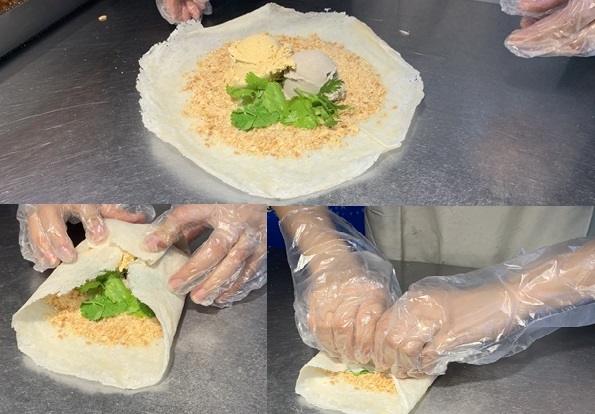
Taro Balls
Soft, bouncy, and a little bit nostalgic, Taro Balls are a beloved Taiwanese dessert known for their chewy texture and delicate, earthy flavor. Whether served hot or cold, these colorful mochi-like nuggets are a key component of traditional Taiwanese sweet soups and shaved ice desserts and they’ve become a favorite comfort food for locals and dessert lovers around the world.
Taro Balls are chewy, glutinous dough balls made from mashed taro and tapioca starch (or sometimes sweet potato starch). When boiled, they become tender with a pleasantly elastic, QQ (chewy) texture-similar to mochi, but a bit firmer. They’re usually served with a mix of other ingredients like sweet potato balls, mung beans, red beans, boba, grass jelly, or shaved ice, depending on whether you prefer your dessert hot or cold.
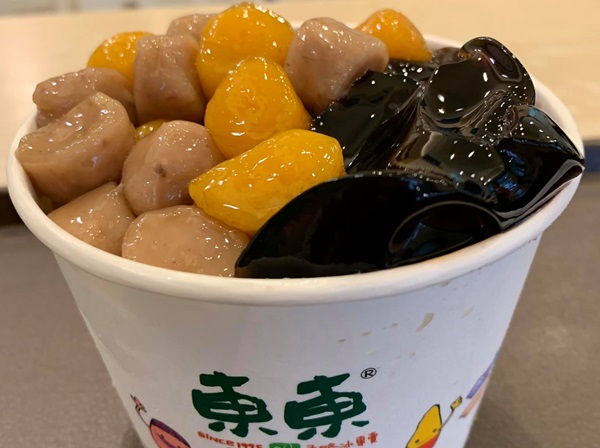
Sweet Potato Balls
One of the most fun and addictive snacks you’ll come across in a Taiwanese night market is the Sweet Potato Ball. These golden, bouncy little treats are beloved for their crisp outer shell, chewy mochi-like center, and their naturally sweet, earthy flavor. Simple yet irresistible, sweet potato balls have become a staple street snack all across Taiwan.
Sweet Potato Balls are deep-fried dough balls made primarily from mashed sweet potatoes and tapioca starch. When fried, they puff up into airy, golden spheres with a crisp exterior and a soft, chewy inside. Despite being deep-fried, they aren’t greasy at all-thanks to the tapioca starch, which creates that signature mochi-like texture. They’re often served in a paper bag or cup and are eaten hot and fresh right from the fryer. You’ll usually find them being made to order at street stalls, where vendors stir and press them in a wok to make sure they stay round and perfectly puffed.
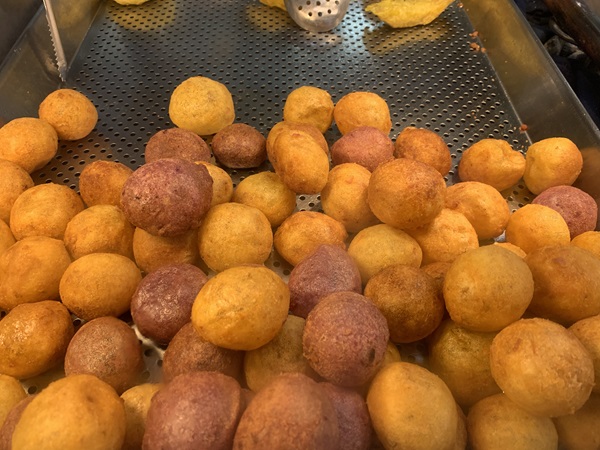
Wheel Cake
Wheel Cake is a popular Taiwanese street food that has captured the hearts of locals and tourists alike. This warm, round dessert is a beloved snack found at many night markets, offering a delightful combination of soft, chewy texture with a crisp outer shell and a sweet or savory filling. Let’s dive into what makes the wheel cake such a distinctive and delicious treat.
The name “wheel cake” comes from the snack’s shape: round and slightly flattened, resembling a wheel. This dessert is made from a simple, soft batter that’s cooked in a special round mold, giving it its signature shape. The outer layer is slightly crispy, while the inside remains soft and fluffy, making each bite a satisfying contrast in texture. Traditionally, wheel cakes are filled with sweet ingredients like red bean paste, but as the dish has evolved, savory fillings have become more common as well. The versatility of the filling options is one reason why this snack is so popular among a wide variety of tastes.
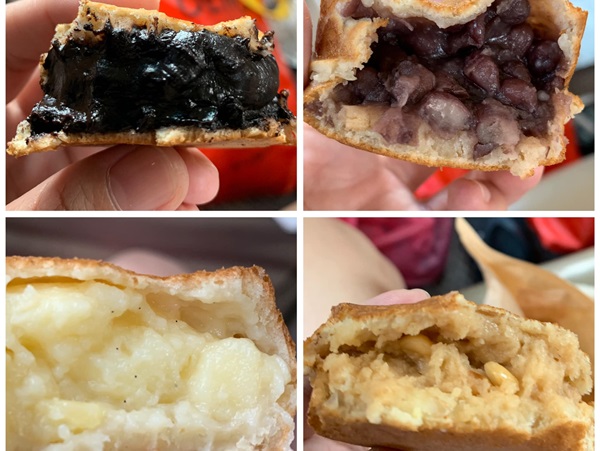
Beef Noodle Soup
If there’s one dish that truly represents the heart and soul of Taiwanese cuisine, it’s Beef Noodle Soup. This hearty and flavorful dish has been a staple of Taiwanese food culture for decades and is widely loved for its rich, comforting broth, tender beef, and perfectly cooked noodles. It’s a dish that can be found in almost every corner of Taiwan from bustling street vendors to upscale restaurants and has become a national comfort food.
Beef Noodle Soup is a savory and aromatic soup consisting of beef (usually braised or stewed), noodles, and a flavorful broth. The beef used in the dish is typically beef shank, brisket, or short ribs, which are chosen for their ability to become tender and flavorful after hours of slow cooking. The noodles are often wheat-based, with a chewy, slightly firm texture that perfectly complements the rich broth.
The key to a perfect Beef Noodle Soup lies in the broth. It’s usually beef-based, made by simmering beef bones, spices, and aromatics such as ginger, garlic, star anise, and soy sauce. This results in a flavorful, aromatic, and slightly savory broth that’s the ideal backdrop for the tender beef and noodles. The soup is often garnished with scallions, pickled mustard greens, and sometimes a touch of chili oil, making it both flavorful and satisfying.
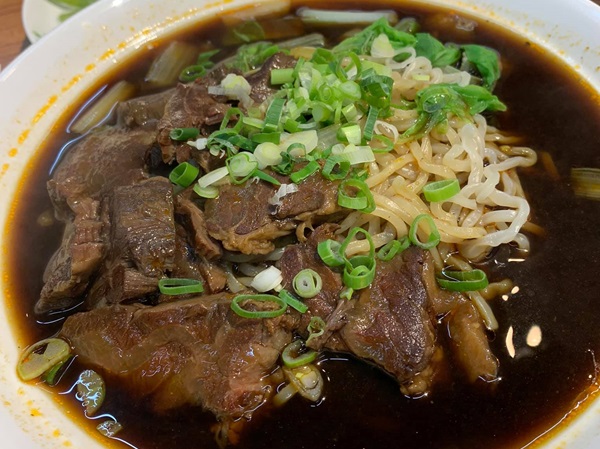
Egg Crepe
One of the most beloved and iconic breakfast dishes in Taiwan is the Egg Crepe, a savory and satisfying dish that combines the delicate flavors of egg, savory seasonings, and a soft, chewy pancake-like wrapper. Often eaten as a quick breakfast or snack, Egg Crepe is a comforting, versatile dish that can be customized with a variety of fillings and toppings to suit different tastes.
An Egg Crepe is a type of Taiwanese pancake made by frying a thin, wheat flour-based crepe and then cracking an egg onto the surface while it’s still cooking. The egg is then spread out to cover the crepe before it’s folded and served. The result is a warm, soft crepe with a tender, slightly runny egg layer that adds richness and flavor.
In its most basic form, an egg crepe typically includes just the crepe and egg, but many variations include additional fillings or toppings, such as cheese, bacon, sausage, scallions, pickled vegetables, and soy sauce. The dish is usually served with a drizzle of sweet soy sauce or sriracha to add a bit of savory or spicy flavor, making it a satisfying meal to kick-start the day.
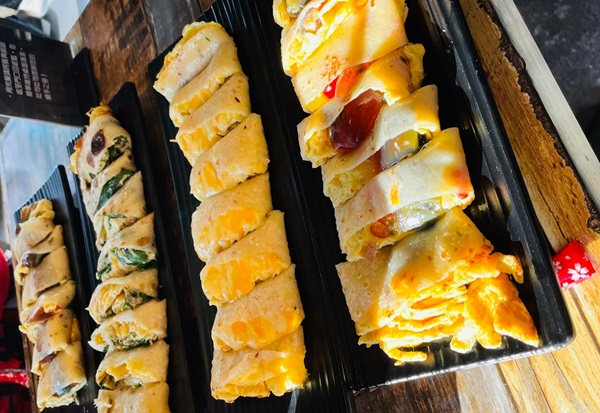
Black Pepper Bun
One of the most popular and irresistible street foods in Taiwan is the Black Pepper Bun. This savory snack has been enjoyed by locals and tourists alike for decades, and its bold, peppery flavor and crispy texture make it a memorable culinary experience. Often found at night markets and street food stalls, the Black Pepper Bun is a must-try for anyone visiting Taiwan, or anyone who loves flavorful, portable street food.
A Black Pepper Bun is a type of savory pastry filled with a spiced pork mixture, black pepper, and a range of other seasonings, then baked in a tandoor-like clay oven (or in modern times, an oven with a similar high heat). The result is a crispy, golden-brown outer crust with a succulent, peppery filling inside. The combination of the spicy, aromatic filling and the crisp, chewy dough makes it a savory and satisfying snack.
What sets the Black Pepper Bun apart from other stuffed buns or pastries is its distinctive peppery flavor, which is the star of the dish. The black pepper is not just a seasoning, but rather the bold primary ingredient that infuses every bite with a punch of heat and spice. It’s an ideal street food-compact, easy to eat on the go, and packed with flavor.
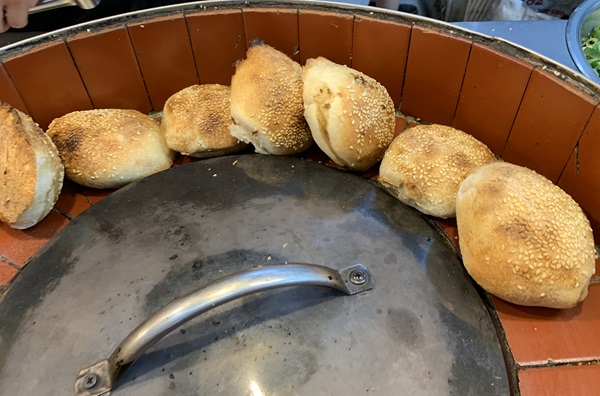
Pan-Fried Buns
If you’re walking through a Taiwanese night market and hear the sizzle of something hitting a hot pan, you might be getting close to a stall selling Pan-Fried Buns, known in Mandarin as Shēng Jiān Bāo (生煎包). These buns are the perfect bite-sized bundle of crispy, juicy, and fluffy all in one.
What makes pan-fried buns so irresistible is the contrast in textures: a soft, fluffy top like a steamed bun, a golden-brown crispy bottom, and an ultra-juicy pork filling that bursts with flavor. The filling often includes minced pork, ginger, green onions, and a touch of sesame oil — simple ingredients elevated by the cooking technique.
The magic happens in the pan. The buns are first placed in a hot skillet, bottoms-down, then water is added and the pan is quickly covered to steam them. Once the water evaporates, the bottom crisps up, giving that irresistible crunch with every bite.
They’re typically served hot and fresh off the pan, sometimes topped with sesame seeds or scallions, and best enjoyed with a splash of vinegar or chili sauce.
Bite carefully — the savory broth inside is piping hot and ready to surprise you (and maybe your shirt)!
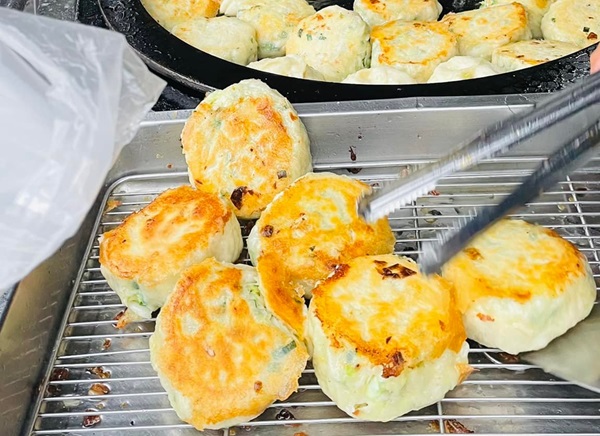
Strawberry Daifuku
Soft, chewy, and bursting with fruity freshness, Strawberry Daifuku is a beautifully simple Japanese-inspired dessert that has become beloved in Taiwan, especially during strawberry season. It’s a delightful combination of textures and flavors: a juicy whole strawberry wrapped in a layer of sweet red bean paste and encased in pillowy, stretchy mochi.
Strawberry Daifuku is a type of mochi (glutinous rice cake) with a whole fresh strawberry tucked inside, often paired with a thin layer of anko (sweet red bean paste) or sometimes custard, cream, or chocolate. The result is a soft, squishy, slightly sticky ball with a bright, tart, and juicy center that perfectly balances the sweetness of the outer layers.
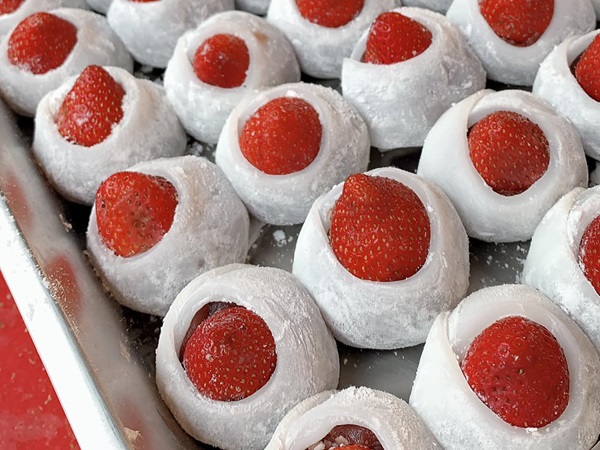
Ba Wan
One of Taiwan’s most unique and comforting snacks is Ba Wan, a chewy, savory dumpling that’s popular in both the streets and homes of Taiwan. Originating from the central part of the island, Ba Wan has become a beloved treat across the entire country. At its core, Ba Wan is made of a thick, translucent dough made from a mix of rice flour and cornstarch, giving it a uniquely chewy, jelly-like texture. This dough is molded around a savory filling – typically minced pork, bamboo shoots, mushrooms, and sometimes a touch of shrimp, all seasoned with soy sauce, five-spice powder, and other aromatics.
What makes Ba Wan especially delicious is the contrast of textures: the chewy dough and the tender, flavorful filling create a satisfying bite. After the dumplings are assembled, they’re steamed or boiled until the dough becomes soft and translucent, giving the dish a glossy finish.
Once cooked, Ba Wan is often served with a sweet-savory sauce, and sometimes topped with cilantro or pickled vegetables for added freshness and balance. Some variations include a light stir-fry before serving, giving the dumplings a slightly crispy edge. The dish is often eaten as a snack or a side dish with a bowl of rice, perfect for those looking for something hearty yet delicate. Whether you’re at a night market or a family-run eatery, Ba Wan is a must-try Taiwanese delicacy that showcases the island’s love for chewy textures and flavorful fillings.
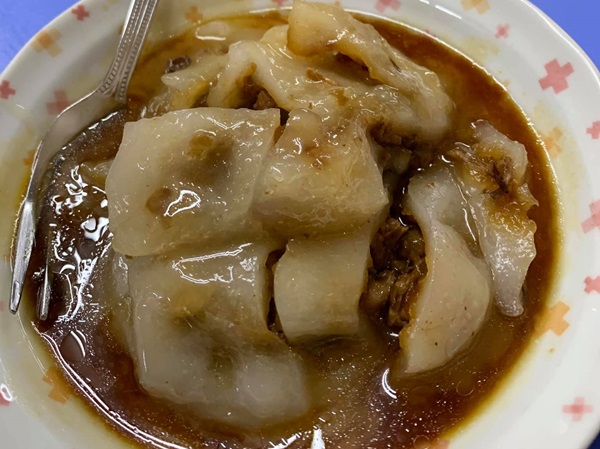
Bubble Milk Tea
Born in Taiwan and beloved worldwide, bubble tea is a must-try in its homeland. Whether you like it classic (black tea + milk + boba) or trendy (brown sugar, oat milk, fruit teas), Taiwan has the best and most creative options.
Pro tip: Try it from Tiger Sugar, 50 Lan, or a local mom-and-pop tea shop.
Taiwanese Shaved Ice
When you think of Taiwanese desserts, shaved ice is one of the most iconic and refreshing treats that instantly comes to mind. A beloved summer snack, this simple yet delightful dish is perfect for Taiwan’s hot and humid weather, offering a cooling escape and a burst of sweet flavors. But it’s not just about the ice; it’s about the toppings, the texture, and the creativity that makes Taiwanese shaved ice a unique experience.
At its core, Taiwanese shaved ice is a mound of finely shaved ice topped with an assortment of sweet and savory ingredients, offering a mix of textures and flavors in every bite. It’s a dish that you’ll find at virtually every night market, street food stall, and dessert shop across Taiwan, often customized to suit personal tastes.
The beauty of Taiwanese shaved ice is its versatility. It’s not just about the ice; it’s about what you pile on top. The shaved ice is finely shaved to create a soft, fluffy texture that melts in your mouth, and the toppings can range from traditional sweet beans and fruit to more modern additions like ice cream and chewy tapioca pearls.
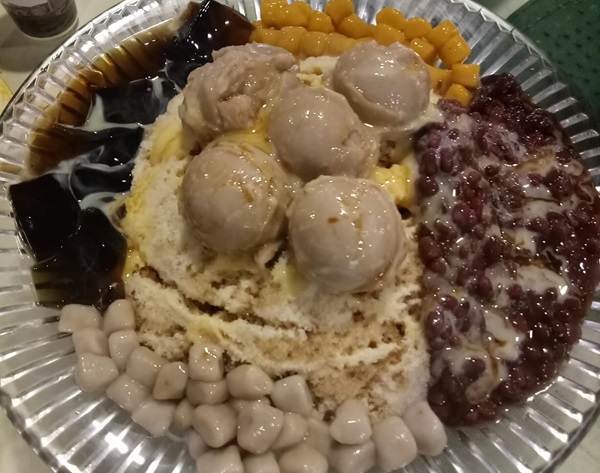
Shaved snow
If you’ve ever had the chance to try Taiwanese desserts, then shaved snow is likely one that stands out for its uniquely smooth texture and light, airy quality. Unlike traditional shaved ice, which consists of finely shaved ice, shaved snow takes the concept to a whole new level with a creamy, almost melt-in-your-mouth sensation. This refreshing treat is a popular dessert in Taiwan and has gained international popularity in recent years. Here’s everything you need to know about this delightful treat.
Shaved snow is a modern Taiwanese dessert that is made by freezing flavored milk or fruit puree into a block and then finely shaving it into delicate, snow-like flakes. The result is a soft, silky texture that resembles fresh, light snow-hence the name shaved snow. While traditional shaved ice is made with plain ice, shaved snow is made with a frozen base that is creamy, flavorful, and incredibly smooth. This gives the dessert a richer taste and a texture that feels like it is slowly melting as it touches your tongue.
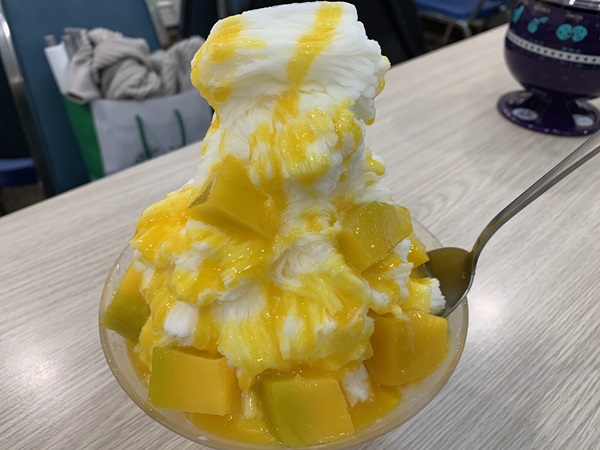
Mein Mein Ice
If you’re craving something cool, creamy, and melt-in-your-mouth smooth, look no further than Mein Mein Ice – Taiwan’s ultra-soft version of shaved ice. Sometimes translated as “cotton ice” or “fluffy ice,” this dessert is like a cross between traditional shaved ice and ice cream, offering a light, silky texture and rich flavor all in one frosty bite.
Mein Mein Ice is a soft, fine-textured shaved ice dessert made by shaving frozen blocks of flavored milk or juice into delicate, airy ribbons. The name “mein mein” literally means “cottony” or “soft and fluffy,” and that’s exactly how it feels on your tongue—cool and creamy, with a texture like fresh snow or whipped gelato. Unlike regular shaved ice that uses plain ice topped with syrup, Mein Mein Ice starts with flavored ice blocks, so the taste is already infused into every bite.
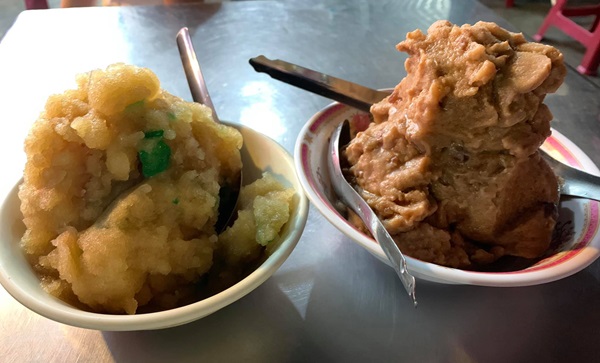
Smoothies
Refreshing, colorful, and naturally energizing, smoothies have become a beloved drink option in Taiwan, especially during the sweltering summer months. Made by blending fresh fruits, ice, and sometimes yogurt, milk, or juice, smoothies offer a cool, creamy treat that’s both delicious and often packed with vitamins and fiber.
A smoothie is a thick, blended beverage made from a base of fruit or vegetables, mixed with liquids like water, juice, milk, or plant-based alternatives. Unlike juices, smoothies retain the fiber from the fruit, making them more filling and nutritious. In Taiwan, smoothies are often fruit-forward, made with tropical ingredients like mango, banana, pineapple, lychee, or dragon fruit, and can be customized to your taste—whether you like it creamy, icy, tangy, or sweet.
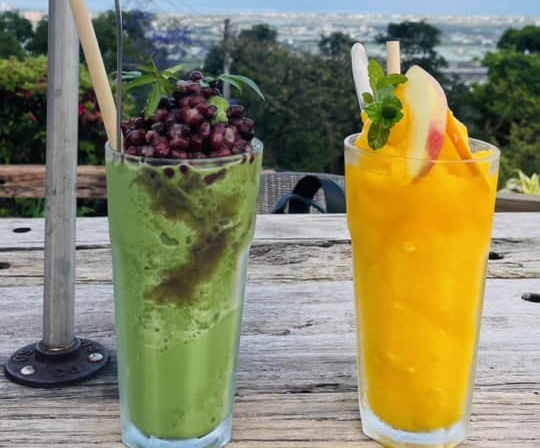
Grilled Kebab
Sizzling over open flames and dripping with juicy, seasoned goodness, Grilled Kebabs are a go-to favorite at Taiwanese night markets and street food stalls. Whether you prefer beef, chicken, lamb or vegetables, these skewers are marinated, grilled to a smoky flavor and sprinkled with delicious spices, making them perfect for a late night snack or sharing with friends.
In Taiwan, a grilled kebab typically means chunks of marinated meat or vegetables threaded onto bamboo or metal skewers, then grilled over charcoal or gas flames. Influenced by Chinese BBQ and Middle Eastern-style skewers, these kebabs are packed with bold, smoky flavor and seasoned with a signature spice mix after grilling.
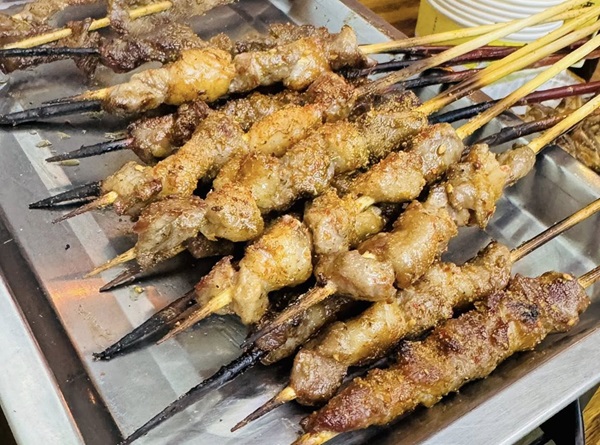
Candied Hawthorn Berries
Bright, shiny, and delightfully tart, Candied Hawthorn Berries also known as Tanghulu are a nostalgic street snack that originated in northern China, but have since become popular in parts of Taiwan as well. These treats feature skewered hawthorn berries dipped in a crisp shell of hardened sugar syrup, creating a beautiful contrast of sweet, sour, and crunchy in every bite.
At their core, Candied Hawthorn Berries are whole Chinese hawthorn fruits (similar to tiny crabapples) skewered on a bamboo stick and coated in a thin, glossy layer of caramelized sugar. The outer shell provides a satisfying crackle, while the inside bursts with tangy, fruity flavor. Traditionally made with fresh hawthorn berries, modern versions may use strawberries, grapes, cherry tomatoes, or even kumquats but hawthorn remains the iconic original.
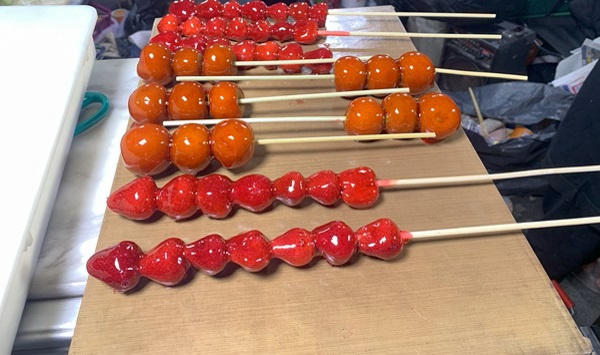
Grilled King Oyster Mushroom
One of the underrated stars of Taiwanese night markets is the humble yet incredibly satisfying Grilled King Oyster Mushroom. Thick, meaty, and naturally full of umami, these mushrooms are flame-grilled to perfection and seasoned with a savory spice mix that keeps you coming back for more.
Grilled King Oyster Mushroom is a vegetarian street snack made from large slices or chunks of king oyster mushrooms, also known as eringi. These mushrooms are known for their firm, meaty texture—almost like scallops or chicken when cooked and they absorb marinades and seasonings beautifully. Once grilled, they become juicy on the inside, slightly crispy on the edges, and bursting with smoky, savory flavor.
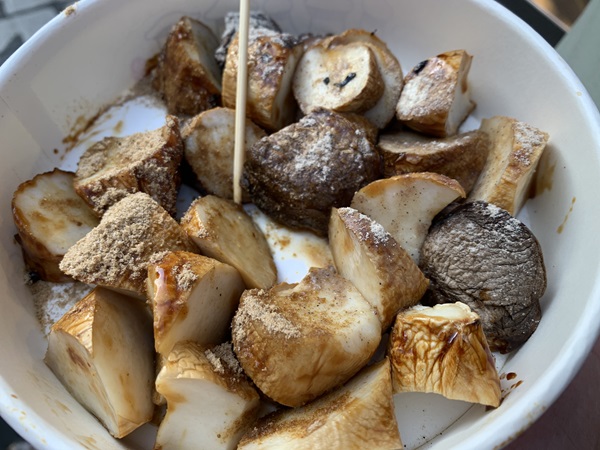
Egg Cake
Simple, sweet and nostalgic, egg pancakes are a beloved Taiwanese snack that brings back childhood memories for many locals. Often found at street stalls and night markets, these mini golden sponge cakes are warm, soft and slightly sweet, perfect for enjoying on the go or sharing with friends.
Egg Cake is a small, bite-sized sponge cake made with a basic batter of eggs, flour, sugar, and baking powder. It’s similar to a Western sponge cake or madeleine but usually lighter and slightly chewy, with a gently crispy exterior right off the griddle. Traditionally, they are cooked in special cast-iron molds, often shaped like fish, stars, cartoon characters, or simple ovals. The finished product is a pan of small golden cakes that are fluffy on the inside and light brown on the outside.

Dongshan Duck Head
If you’re looking to dive into the more adventurous side of Taiwanese night market eats, Dongshan Duck Head is a must-try. Originating from Dongshan Township in Yilan County, this unique delicacy has gained fame for its deep, savory flavor, crunchy texture, and complex spice blend. It might sound intimidating at first but one bite, and you’ll understand why it has a cult following.
Dongshan Duck Head is a deep-fried, marinated duck head that’s part of a broader range of braised and fried duck parts—including wings, necks, tongues, intestines, and tofu. It’s all cooked in a richly seasoned soy-based marinade, then deep-fried to give it a slightly crispy exterior and deep, concentrated flavor. The duck heads are typically split in half, exposing the tender meat, brain, and chewy bits, which fans savor for their unique texture and intense taste.
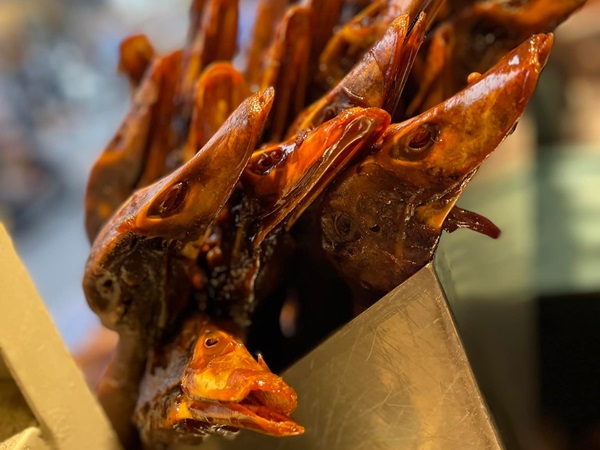
Taiwanese Crepe
Combining French cooking techniques with the flavors of Taiwanese street food, Taiwanese crepes are thin, golden pancakes that are baked to a crisp on a griddle and filled with a variety of sweet or savory delights. Popular with teens and snack lovers alike, they’re a fun handheld snack that’s usually rolled into a cone or folded into a square shape that’s easy to eat, fun to make, and perfect for Instagramming.
Unlike French crepes, which are soft and delicate, Taiwanese crepes are usually thin and crispy and are made on a hot flat plate. Spread the batter evenly into a large round pancake and bake until golden and crispy. Add the filling while the noodles are still on the baking sheet, then fold or roll the whole thing up and serve. It’s a customizable snack, which means you can choose any combination of fillings you want — whether you want ice cream and Oreos, strawberries and whipped cream, or ham, corn, and cheese.

Taiwanese Spring Roll
One of the most beloved and unique Taiwanese snacks is the Taiwanese Spring Roll, a dish that is both delicious and incredibly versatile. Often referred to as the “soft spring roll” or “run bing”, this dish is a savory, rolled creation made with a soft, thin wheat flour wrapper that’s filled with an array of ingredients, making it a perfect combination of textures and flavors.
The Taiwanese Spring Roll is a soft, flat roll made with a thin, chewy wrapper filled with various savory ingredients. It’s similar in appearance to a burrito but is typically more delicate and lighter in texture, featuring a variety of fillings that range from meats to vegetables to fresh herbs. The dish is often eaten as a snack, appetizer, or even as part of a meal, especially in Taiwan’s bustling night markets and street food stalls.
The key characteristic of Taiwanese spring rolls is the soft wrapper, which differentiates them from the crispy, fried spring rolls commonly found in other parts of Asia. This softness, combined with a medley of flavorful fillings, gives the dish a fresh and light profile, making it an ideal snack to enjoy at any time of day.
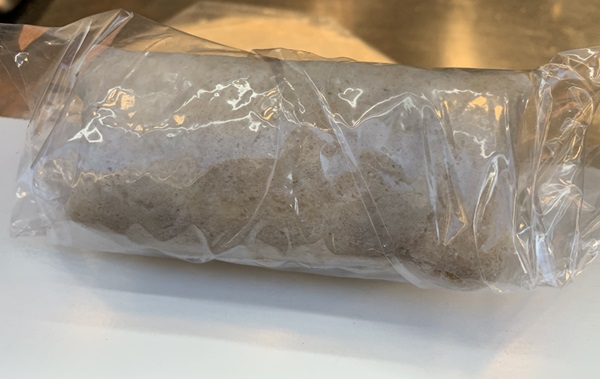
🔥ChiaTe Pineapple Cake / Delivery or Airport Pickup
■ ChiaTe Bakery Pineapple Pastry-Delivery(Home / Hotel) / Airport Pickup (klook)
Prepare your trip to Taiwan?✈️Buy discounted tickets in advance (Klook)
■ EasyCard and SIM Card Package
■ Taipei 101 Observatory Ticket
■ Taipei Double Decker Sightseeing Bus
■ National Palace Museum Ticket
■ Taipei Fun Pass (Taipei 101, National Palace Museum, Taipei MRT, city buses, and 6 Taiwan Tourist Shuttle)
■ Taipei Transport Fun Pass (Taipei MRT, city buses, 6 Taiwan Tourist Shuttle routes, and Maokong Gondol)
■ Taipei Metro (MRT) Day Pass
■ (Taiwan Pass) HSR + MRT + Taiwan Tourist Shuttle
■ Taiwan High Speed Rail Day Pass
■ Taiwan High Speed Rail Ticket for non-Taiwanese Discounts or Buy 1 Get 1
■ Taiwan High Speed Rail Joint Ticket
■ (Taiwan Pass) Taiwan Railways + MRT + Taiwan Tourist Shuttle
